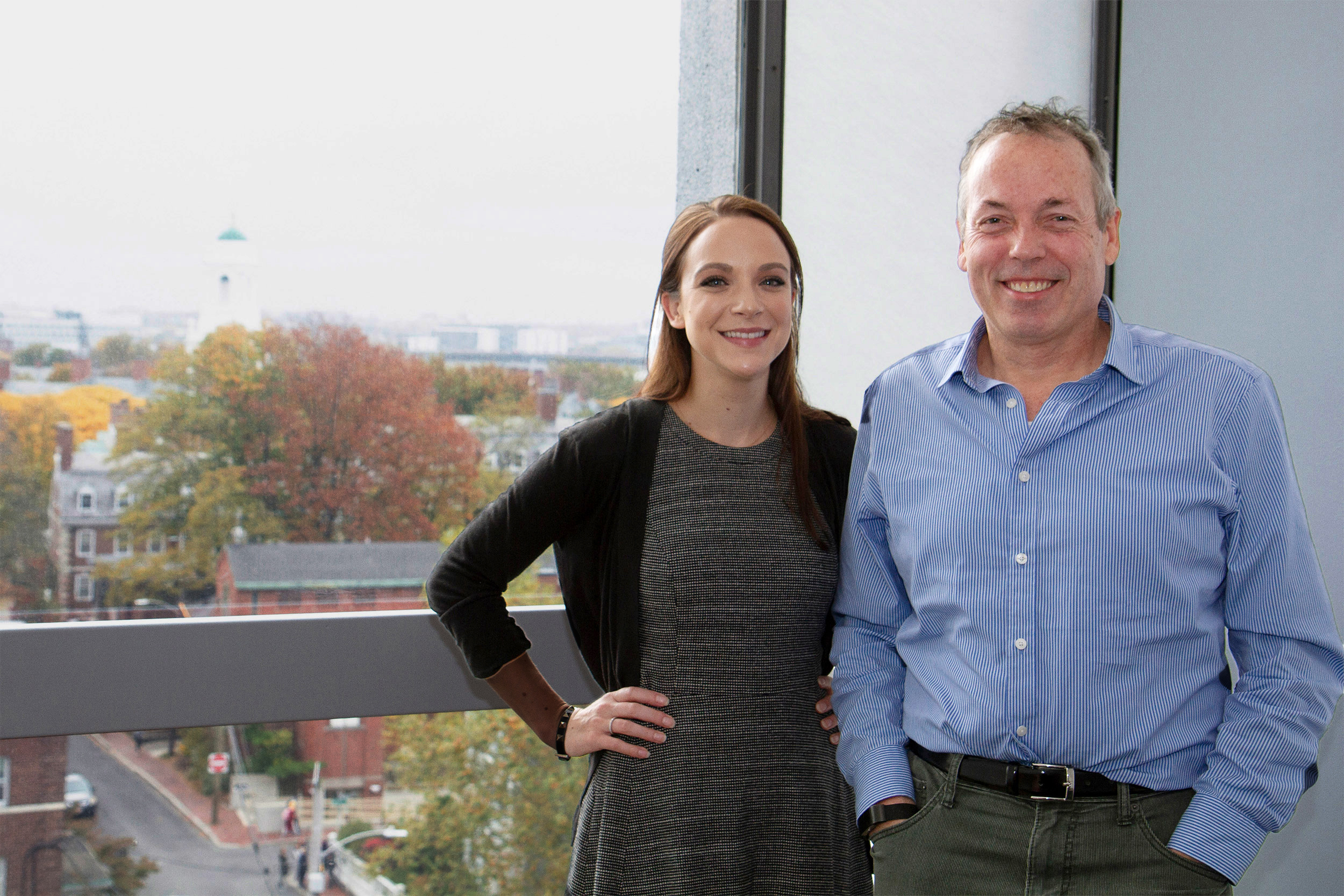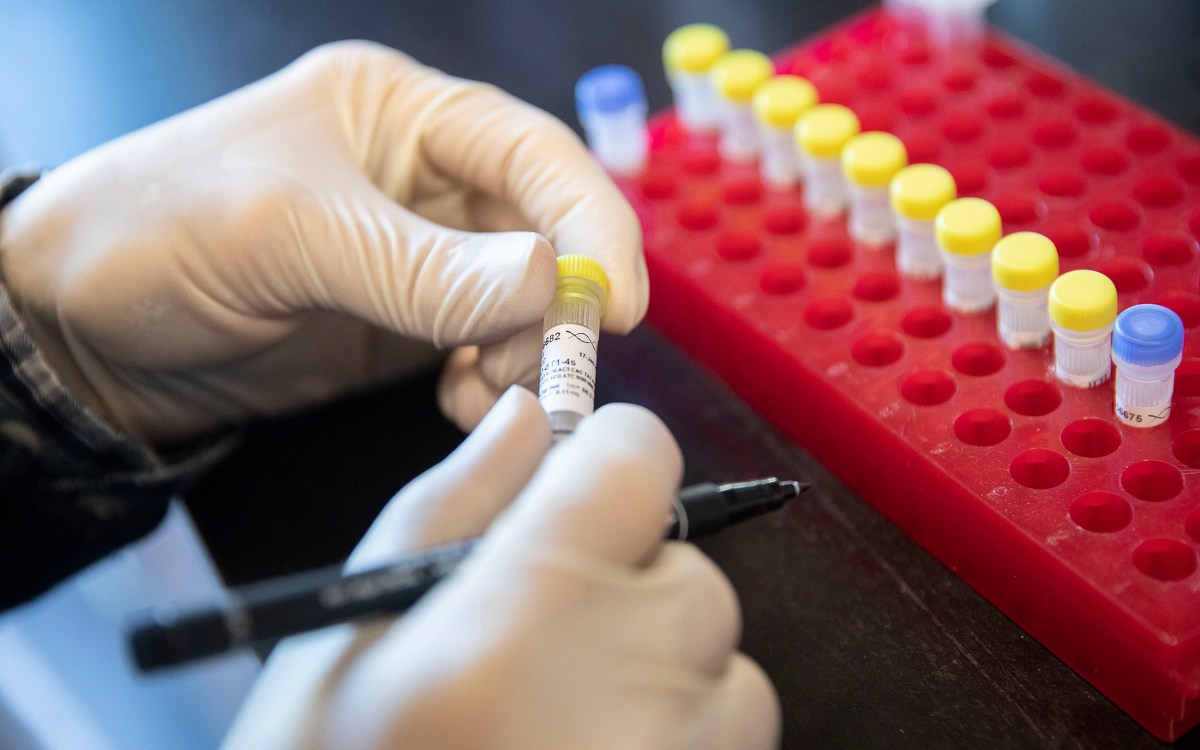
Haircuts can prove difficult for those who experience touch overreactivity. “For a large number of people with autism, light touch can be aversive …,” explains Professor David Ginty.
iStock
New hope for sensory calm
Novel approach to treating tactile hypersensitivity in patients with autism-spectrum disorders
Harvard University and Deerfield Management announced today the selection of a first project for funding under the Lab1636 R&D alliance that aims to advance promising innovations from labs across the University toward the clinical development of novel therapeutics. The project arises from the lab of David Ginty, the Edward R. and Anne G. Lefler Professor of Neurobiology in the Blavatnik Institute at Harvard Medical School (HMS) and a Howard Hughes Medical Institute investigator. Lauren Orefice is a former postdoctoral researcher in the Ginty Lab and now assistant professor of genetics at HMS and Massachusetts General Hospital. In a question-and-answer session, Ginty and Orefice discuss their recent progress toward identifying possible treatments for the touch hypersensitivity that often occurs in people with autism spectrum disorders (ASD), and their hope for further innovation in neuroscience.
Q&A
David Ginty and Lauren Orefice
OTD: How do people experience touch hypersensitivity?
GINTY: Well, the truth is we don’t really know how they experience it. We do know that in certain disorders, including autism, light touch can be highly aversive. In fact, there are several examples of disorders where we see touch overreactivity; a person will react abnormally to what you and I would consider innocuous touch stimuli. For a large number of people with autism, light touch can be aversive, and normal, developmental nurturing touch may also be aversive. We refer to this phenomenon with terms like “tactile avoidance” and “tactile defensiveness.”
OREFICE: People with ASD often describe that certain types of clothing can be itchy or difficult to wear. Haircuts can even be really difficult for people to deal with, and there are certain barbers or hairstylists that they’ll go to. Things like inclement weather, heavy rain, can be really overwhelming or frightening for some people. For most of us, we are not typically aware of the fact that we are sitting in a chair, wearing a sweater, and the air conditioning is on, etcetera. But for some people with autism, some of these tactile aspects of their environment feel more present, or more profound, as though the volume is turned up.
GINTY: Interestingly, we don’t only see this tactile sensitivity in ASD. In other disorders such as neuropathic pain, which can be caused by chemotherapy, diabetes, or damage affecting the somatosensory system, light touch can also be aversive. It can be painful.
“We think there’s a critical need for normal tactile input during an early period in development. We’d like to be able to identify that critical window, to treat tactile overreactivity in young children.”
Lauren Orefice
OTD: For people who are born with this, developmentally, how does it play out over the long term?
OREFICE: This is, I think, a really important aspect of what David and I do in our labs, and what we continue to ask questions about. We’re trying to understand how an abnormal sense of touch impacts the brain and ultimately complex social behaviors.
GINTY: We think that touch is the first sense to develop. The first social exchange between a baby and her parents occurs through the sense of touch. You might say that touch is where social development begins. It’s fascinating that a number of studies in humans, nonhuman primates, and other animals have suggested that normal touch is required for the development of normal cognitive processes.
In our own mouse studies, we found that if a genetic lesion that causes tactile overreactivity is introduced developmentally in the peripheral nervous system, the animals also exhibit behavioral alterations — a fairly profound anxiety-like behavior, for example, and some aberrant social-interaction behaviors. On the other hand, if the very same genetic lesions are introduced in young adult mice, the animals still exhibit the tactile overreactivity, but they don’t exhibit anxiety-like behavior. So there’s a profound link between developmental touch and tactile reactivity and the acquisition of normal behavior.
OTD: So the hope and the hypothesis is presumably that if you can address what’s happening in the peripheral nerves at the right developmental window, you may be able to prevent these kinds of things from appearing down the road.
OREFICE: Exactly. We think there’s a critical need for normal tactile input during an early period in development. We’d like to be able to identify that critical window, to treat tactile overreactivity in young children.
GINTY: Our thinking is that, even in adulthood, preventing touch overreactivity and thus tactile avoidance and defensiveness would be highly beneficial. But we hypothesize that if we could treat it developmentally, then it might also have a long-term consequence of improving anxiety and possibly even social-interaction behaviors later in life.

OTD: Do you think a treatment to reduce tactile overreactivity would be taken lifelong, or during critical periods of development?
GINTY: We don’t know. Long-term treatment beginning early is a good thing for the animal models of ASD. So, based on our mouse studies, we might speculate that the greatest benefits would come from treating tactile overreactivity over the long term. But that’s really up in the air, because human studies have yet to be done.
OREFICE: If we’re speculating, we can imagine that in addition to developmentally improving the sense of touch, a future treatment could also improve acute symptoms in people who are beyond this critical period. Supposing a person knows they’re going to be engaged in a particularly stressful situation, like a cocktail party, perhaps we could dampen these external inputs a little bit for the tactile domain. But we’ve got a long road ahead of us.
OTD: As a researcher, how do you know when it’s time to engage with a corporate partner?
GINTY: For me, it’s pretty easy. My lab, my postdocs and Ph.D. students, are interested in understanding the basic biology and developing new ideas or principles that emerge from that work, revealing new opportunities. Drug development and all that it entails is not our focus, nor is it our strength. Medchem [medicinal chemistry] to identify chemical variants and drug candidates, testing their activity, doing pharmacodistribution analysis, pharmacodynamics, defining optimal modes of delivery and safety measurements, are all labor-intensive and expensive. Those really specialized details of drug development and optimization are best addressed, at least in our case, by a dedicated company that does this for a living.
This is the first time my lab has been able to move something this far that’s this promising. And it took a very talented postdoc in the lab — Lauren — to make it happen. Now, it’s the perfect time for us to move this work out of our labs and the basic biology and discovery realm and move it toward clinical utility with Lab1636.
OTD: What else needs to happen to develop your lab’s insights toward benefiting patients?
GINTY: Well, there’s a lot of space between identifying a pathophysiological mechanism in a mouse model and understanding whether it’s relevant in a human. This presents a strong case for collaborative efforts between clinician-scientists and basic scientists.
If this work is going to be translated, and we’re going to move toward clinical trials, we need to have reliable measurements in humans, especially young kids, so that’s another piece we’re hoping to achieve, with our clinical collaborators.
OREFICE: We don’t assume that every person with autism has profound touch overreactivity. So part of what we’re doing now with our collaborators at Beth Israel and Boston Children’s Hospital is trying to find a quantitative, objective metric of somatosensory overreactivity. If we can do that in adults, and also earlier ages, it will help us identify which patients exhibit touch overreactivity and therefore may benefit from this type of treatment.
OTD: How did the relationship with Deerfield’s Lab1636 come about?
GINTY: The Office of Technology Development here at Harvard is superb. This group was key for moving our project forward because they’re the ones with knowledge of who would be interested in translating the work. They understood what needed to be done to make a compelling case and who, in industry, would have an interest in the work and have the capabilities of moving it forward at a larger scale. They were amazing in terms of making connections and conveying the message of our findings. So in many ways, the technology development office really — it shines here, I’d say.
OTD: From your perspective, how has the trajectory looked, from discovery to translation?
GINTY: The reason we were able to bring our work to this point is that we have developed a strong capability in genetics, electrophysiology, and using the mouse as a model system, which has allowed us to ask about the locus of dysfunction accounting for touch overreactivity in ASD models: Is it a spinal-cord disorder? Is it a peripheral-nervous-system disorder? Does dysfunction in the brain account for touch overreactivity? What nerve cells or neurons are the ones affected, and why? We’re uniquely poised to ask these kinds of questions. And that’s something we’ve been building toward for 20 years.
About three years ago, work by Lauren and her colleagues in the lab made it clear that there may be ways of targeting the peripheral nervous system to reverse touch overreactivity in ASDs. Because of this new therapeutic opportunity, the Blavatnik Biomedical Accelerator and the Q-FASTR funding mechanisms became quite compelling. There was a real translational opportunity arising from the work, which we were excited to pursue. And we were, again, uniquely poised to ask about the potential translatability of the findings. Financial support from the Blavatnik Accelerator and Q-FASTR, and a grant from the Simons Foundation, were critical for helping us define a proof-of-principle pharmacological approach aimed at treating touch overreactivity. These funds allowed the project to move to a point where it became compelling for an outside company to invest the additional resources and capabilities needed to take the work forward.
“There are also millions of people with chronic pain, with limited treatment options. Our dependence on opioids has been highly problematic for obvious reasons. Going forward, my lab is taking a deep dive into understanding the molecular biology of all sensory neuron subtypes.”
David Ginty
OTD: What are you hopeful about, both for this project and more broadly?
GINTY: Well, it’s simple. It would be a dream come true if we could help improve quality of life for people with autism, and for their caregivers as well.
OREFICE: It’s difficult, when you’re a basic scientist, to know when you’ve found something that might actually be beneficial for human health. But when you realize that you might be able to help people and improve the way they experience the world, it’s so rewarding. It motivates me to continue the basic research. So as our project moves into Lab1636, my lab and David’s lab will continue to ask more of the basic biological questions to understand the mechanisms through which tactile overreactivity occurs.
GINTY: There are also millions of people with chronic pain, with limited treatment options. Our dependence on opioids has been highly problematic for obvious reasons. Going forward, my lab is taking a deep dive into understanding the molecular biology of all sensory neuron subtypes. I’m optimistic that over the next few years, in addition to the strategy for reducing tactile overreactivity, new druggable targets on peripheral neurons will be revealed that will allow us to think of new ways to treat chronic pain. Maybe, over time, this approach will help us move away from our clinical reliance on mu opioid agonists.
OTD: Is your perspective any different now having been through this kind of translational experience? David, I hear you talking about finding new druggable targets — is that something that you would have been thinking about five years ago in the same way?
GINTY: For me, yes, I think it would have been. But a difference now is that technology has advanced to the point, especially with deep sequencing, that new potential drug targets are made clear for us to see. My experience with this project makes me excited about the possibility of harnessing our knowledge of peripheral-nervous-system biology, and druggable targets on sensory neurons themselves, to define new therapeutic approaches. That feels compelling to me. I think there’s going to be a lot of room for additional partnering over the next five to seven years for parallel approaches, or complementary approaches, not just for treating disorders involving light-touch overreactivity, but for pain sensation too.
OREFICE: It has changed my perspective in a lot of ways. When we started these projects in mice about five years ago, we had no idea what we would find. And we’ve been very surprised and encouraged by the findings, the robust observations we’ve made.
What it’s taught me most of all is to follow your science, listen to the data, and surround yourself with really intelligent, capable people, including the folks in the Office of Technology Development, who can see your research from different perspectives than how you might normally see it. That can transform everything you’re doing and elevate your work into an entirely new arena.
There’s something really special about being at Harvard for this type of work. Being here, in the right environment, and with great collaborators, we’ve been able to find some really interesting biology that we hope will ultimately help humans.







